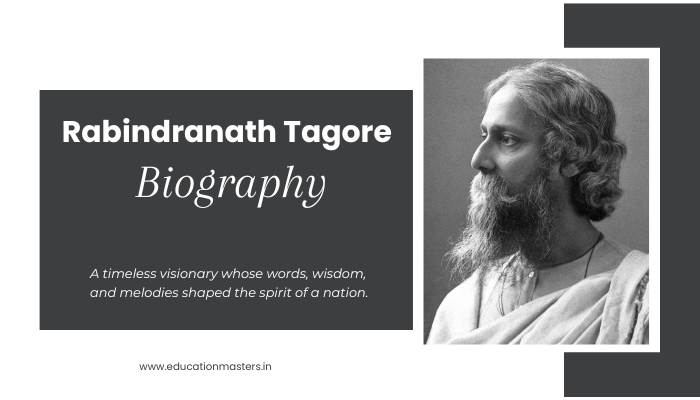Rabindranath Tagore Biography

Rabindranath Tagore was an iconic Indian poet, philosopher, polymath, and Nobel Laureate in Literature. Widely regarded as the "Bard of Bengal", he reshaped Bengali literature and music with his deeply spiritual and humanistic works. Tagore became the first non-European to win the Nobel Prize for Literature in 1913 for his poetry collection Gitanjali. He was also the composer of India’s national anthem "Jana Gana Mana". His influence continues to permeate Indian art, music, and education, making him a towering figure in global literature and intellectual history.
1. Infobox (Summary Table)
|
Field |
Details |
|
Name |
Rabindranath Tagore |
|
Image |
|
|
Caption |
Rabindranath Tagore in later years |
|
Birth Name |
Rabindranath Thakur |
|
Birth Date |
May 7, 1861 |
|
Birth Place |
Jorasanko Thakur Bari, Calcutta, Bengal Presidency, British India |
|
Death Date |
August 7, 1941 |
|
Death Place |
Jorasanko Thakur Bari, Calcutta, Bengal Presidency, British India |
|
Resting Place |
Rabindra Bhavan, Jorasanko, Kolkata |
|
Nationality |
Indian |
|
Citizenship |
British Indian |
|
Other Names |
Gurudev, Kavi Guru, Biswakabi |
|
Education |
Home tutored, University of London (dropped out) |
|
Alma Mater |
University College London (UCL) |
|
Occupation |
Poet, Philosopher, Writer, Musician, Painter, Reformer, Educator |
|
Years Active |
1878–1941 |
|
Known For |
Gitanjali, Nobel Prize, National Anthem, Santiniketan, Visva-Bharati |
|
Height |
5 ft 8 in (approx.) |
|
Notable Works |
Gitanjali, Gora, Ghare Baire, Jana Gana Mana, Amar Shonar Bangla |
|
Spouse(s) |
Mrinalini Devi (m. 1883–1902) |
|
Children |
Five children (three daughters, two sons) |
|
Parents |
Debendranath Tagore (father), Sarada Devi (mother) |
|
Relatives |
Dwijendranath Tagore (brother), Abanindranath Tagore (nephew) |
|
Website |
2. Early Life and Education
Rabindranath Tagore was born on May 7, 1861, into the prominent Tagore family in Jorasanko, Calcutta, then part of the Bengal Presidency of British India. The youngest of thirteen children, Rabindranath was raised in a culturally rich environment where art, music, and literature were an everyday affair.His father Debendranath Tagore was a religious reformer and founder of the Brahmo Samaj, while his mother Sarada Devi passed away when he was young. Tagore’s family hosted regular literary discussions, musical recitals, and theatrical performances, deeply influencing his early interests.Tagore received his early education at home under private tutors and never attended a formal school. At the age of 17, he went to England to study law at University College London but soon dropped out, choosing to pursue his literary and creative passions instead.
3. Career
Early Literary Endeavors
Rabindranath Tagore began writing poetry at the age of 8 and published his first substantial work Bhanusimha Thakurer Padabali under a pseudonym. His literary style was influenced by Vaishnava poetry, Upanishads, and Bengali folklore.
Rise to Fame
Tagore's poetic masterpiece Gitanjali was translated into English by himself and published in 1912, catching the attention of literary figures like W.B. Yeats, who penned the introduction to its English edition. In 1913, Tagore was awarded the Nobel Prize for Literature, the first non-European to achieve this honor.
Educational Reformer
In 1901, he founded an experimental school at Santiniketan, which later became the Visva-Bharati University. His vision for education emphasized creative freedom, natural learning, and cultural integration, blending Western and Eastern philosophies.
Political and Social Views
Tagore was a social reformer who wrote extensively on nationalism, identity, and humanism. Although initially supportive of the Swadeshi Movement, he later criticized extreme nationalism. He renounced his knighthood in 1919 after the Jallianwala Bagh massacre, making a bold statement against British colonial atrocities.
4. Personal Life
Marital Life
Rabindranath Tagore married Mrinalini Devi in 1883 when he was just 22 and she was 10. Though an arranged marriage, they shared mutual respect. Mrinalini passed away in 1902, and her death had a profound emotional impact on him.
Children
He had five children, two of whom died in childhood. The loss of his wife, children, and other close relatives reflected deeply in the themes of mortality and melancholy in his later works.
Hobbies and Interests
Tagore was also a composer, painter, and philosopher. He composed over 2,000 songs, known as Rabindra Sangeet, which remain vital to Bengali culture. His artistic career flourished in later life when he began painting at the age of 60.
Philanthropy and Activism
Tagore supported rural development, women’s education, and social reform, often using Visva-Bharati as a model for holistic community growth. He also contributed to intercultural dialogue through his international tours.
5. Death and Legacy
Death
Rabindranath Tagore died on August 7, 1941, at his ancestral home in Jorasanko, Kolkata, after a prolonged illness. His death marked the end of an era in Indian art and literature.
Legacy
Tagore's influence transcends borders and disciplines:
- Jana Gana Mana (India) and Amar Shonar Bangla (Bangladesh) are national anthems written by him.
- His educational model inspired future pedagogical reforms.
- Philosophers, artists, and statesmen like Albert Einstein, Gandhi, and Nehru admired him.
His work continues to be studied globally in the context of post-colonial literature, universal humanism, and creative education.
6. Awards and Honors
- Nobel Prize for Literature (1913)
- Knighthood by the British Crown (1915) – renounced in 1919
- Honorary Doctorates from Oxford University, Columbia University, and Dhaka University
- National Poet of Bangladesh
- Commemorated on Indian currency notes, stamps, and UNESCO events
7. Bibliography / Notable Works
Notable Literary Works
- Gitanjali (1910 / Eng. 1912)
- Gora (1910)
- Ghare Baire (The Home and the World, 1916)
- Chokher Bali (1903)
- Manasi, Sonar Tari, Balaka, Kalpana (Poetry collections)
Drama
Dak Ghar, Raktakarabi, Chitrangada
Short Stories
Kabuliwala, Postmaster, The Hungry Stones
Songs
- Jana Gana Mana
- Amar Shonar Bangla
- Over 2,000 Rabindra Sangeet compositions
Paintings
Exhibited in Europe and the USA during the 1930s
8. References
- Dutta, Krishna & Robinson, Andrew. Rabindranath Tagore: The Myriad-Minded Man (1996)
- Tagore, Rabindranath. Gitanjali (1912)
- Visva-Bharati University official site: www.visvabharati.ac.in
9. External Links
सरकारी नौकरियों, जीके अपडेट्स और करेंट अफेयर्स की ताज़ा जानकारी सबसे पहले पाने के लिए:
-
हमारे WhatsApp चैनल को फॉलो करें:
https://whatsapp.com/channel/0029Vb6sjZz0wajwDXcd5B0U -
हमारे Telegram चैनल को फॉलो करें:
https://t.me/educationmastersin -
हमारे Facebook Page को फॉलो करें:
https://www.facebook.com/educationmastersindia

![100+] Rabindranath Tagore Wallpapers ...](https://wallpapers.com/images/hd/rabindranath-tagore-greenish-fpt8329ptq23byer.jpg)




.jpg)
.png)
.jpg)
.jpg)
.jpg)

